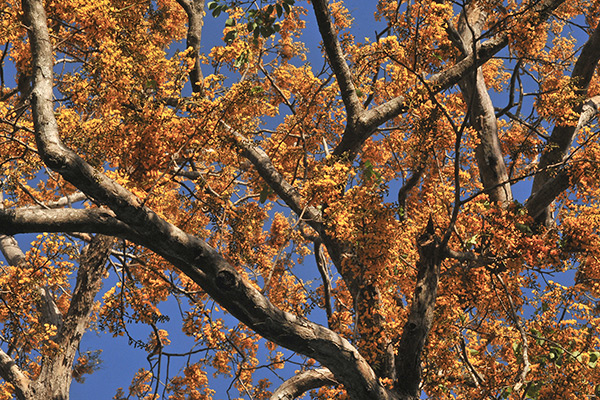Tropical Dry Forest
One of the principle objectives of the Lost Canyon Private Nature Reserve is the restoration and conservation of Nicaragua’s vanishing tropical dry forest flora. Tropical dry forest is the most endangered of all tropical ecosystems. In Nicaragua this is due to ecosystem’s relatively resilient soils and more livable annual rain fall totals, making tropical dry forests Nicaragua’s most intensively cultivated and populated ecosystem. To many, the term “tropical dry forest” appears to be an oxymoron. Indeed tropical dry forest is an ecological paradox. Trees and plants must withstand the intense climatic contrast of 6 months of tropical rains (May-Oct) followed by 6 months of near drought (Nov-April) annually. This has created a highly specialized flora with varying techniques for competing for light during the wet half of the year, when tropical dry forest is lush and dense, and then surviving the extreme stress of desert-like conditions for the other half. During the dry period most tropical dry forest trees located away from surface or shallow ground water shed foliage and the majority of flowering and seed production takes place.
Change Climate Change
The Lost Canyon Nature Reserve annually reforests areas of the nature park damaged by previous land owners. Reforestation efforts are targeted at maximizing water infiltration, propagating endangered flora, controlling soil erosion and maximizing the variety of food sources for Lost Canyon’s wildlife. For these reasons Lost Canyon has selected trees for reforestation that are native endangered species, fruit/nut trees and quick growing shade species. Planting is done in random, mixed fashion – one that mimics natural re-growth – with an eye to quickly creating light competition and cooling soil temperatures, essential in tropical dry forest to fomenting rapid natural re-growth. Lost Canyon also combines linear planting strategies (to optimize future seed dispersion) with high density reforestation in areas critical to subterranean water supplies. Due to the reserve’s mountainous rocky terrain and high daytime temperatures, reforestation is both a logistical and physical challenge. Each hole is dug with a sharp metal stake to dislodge stones and trees are transported to reforestation sites on horseback. Lost Canyon is grateful to report that reforestation efforts have been a success, with more than 7,600 trees representing 29 species planted from 2006-2020. We are proud to do our part in the fight for positive climate change while simultaneously working to restore endangered tropical dry forest biodiversity and Lake Managua’s northern watershed.
Lost Canyon Trees
The Lost Canyon Nature Reserve protects more than 100 species of trees, some of which are in danger of extinction, such as Laurel Macho (Cordia gerascanthum), Coyote (Platymiscium pinnatum), Tempisque (Syderoxylon capiri) Caoba de Pacifico (Swietenia humilis), Guayacán Real (Guaiacum sanctum), Nicaraguan Rosewood (Dalbergia retusa), Guacuco (Eugenia salamensis) and Guacamaya (Astronium graveolens). At the lowest point of the reserve, in the forest that borders the principle stream, are Lost Canyon’s grandest trees, some well over a century old. Old-growth species include Ceiba (Ceiba pentandra), Almendro del Río (Andira inermis), Pochote (Bombacopsis quinatum), Cenízero (Albizia saman), Jobo (Spondias mombin), Mora (Maclura tinctoria), Areno (Licania arborea), Melero (Thouinidium decandrum), the Nicaraguan national tree Madroño (Calycophyllum candidissimum), Palo de Sangre (Pterocarpus rohrii) and the endangered Granadillo (Dalbergia tucurensis). On the sandy banks of the principle stream, rise young strands of Guarumo (Cercropia spp), Capulín (Muntigia calabura) and Cuajinicuil (Inga vera) trees. In the shade of the bigger trees are some wildlife favorites, like the Uva Montesa (Vitis tiliifolia). In the small flat beneath the eastern wall of the canyon, diverse fruit trees can be found like Níspero (Manikara zapota), Guayaba (Psidium guajava), Zapote (Pourteria sapota), Marañon (Anarcadium occidentale), Cacao (Theobroma cacao), Achiote (Bixa orellana), Aguacate (Persea americana) and Jocote (Spondias purpurea), which are mixed with more common forest species like Guanacaste Blanco (Albizia niopoides), Tigüilote (Cordia dentata), Güiligüiste (Karwinskia calderonii), Guacimo Molenillo (Luehea candida) and Guacimo Ternero (Guazuma ulmifolia). On the opposite canyon flat, leading up to the western ridge of the canyon, are numerous examples of Madero Negro (Gliricidia sepium), Chicharón (Rheedera trinervis), Jícaro (Crescentia alata), Guayabillo (Inga jinicuil), Roble Macuelizo (Tabebuia rosea) and Guanacaste (Enterolobium cyclocarpum). At elevation on the western ridge trees such as Guapinol (Hymenaea courbanil), the Nicaraguan national flower Sacuanjoche (Plumeria rubra) Chiquirín (Myrospermum frutescens), Quebracho (Cojoba arborea), Carao (Cassia grandis), Cedro Real (Cedrela odorata), Nancite (Byrsonima crassifolia), Jagua (Genipa americana), Jocote de Garrobo (Spondias sp), Ojoche (Brosimum alicastrum), Camajuche (Cochlospermum vitifolium) and Gavilán (Albizia guachepele) mix with previously mentioned species. Further up the western ridge, in the highest reaches of the nature reserve, species like Chaperno (Lonchocarpus minimiflorus), Cortés (Tabebuia chrysanta), Aguja de arra (Xylosma characantha), Escobillo (Phyllostylon brasiliensis), Jiñocuabo (Bursera simaruba), Nacascolo (Caesalpinia coriaria) and Talalate (Gyrocarpus americanus) are more frequent.
















